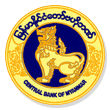Central Bank of Myanmar
| |||
| Headquarters | Naypyidaw | ||
|---|---|---|---|
| Established | 2 July 1990 | ||
| Governor | Kyaw Kyaw Maung[1] | ||
| Central bank of | Myanmar (Burma) | ||
| Currency |
Myanmar kyat MMK (ISO 4217) | ||
| Preceded by |
Union Bank of Burma People’s Bank of Union Bank of Burma | ||
| Website |
www | ||
The Central Bank of Myanmar (Burmese: မြန်မာနိုင်ငံတော်ဗဟိုဘဏ်; MLCTS: myan ma naing ngam taw ba ho bhan IPA: [mjəmà nàinŋàndɔ̀ bəhòʊbàn]; abbreviated CBM) is the central bank of Myanmar (formerly Burma). It was established under the Central Bank of Myanmar Law in 1990.[2]
Organisation
Its headquarter located in Naypyidaw, and it has branches in Yangon and Mandalay. The Governor is Kyaw Kyaw Maung and three Vice Governors are Set Aung, Khin Saw Oo and Soe Min. The Central Bank of Myanmar became an autonomous and independent regulatory body by the Central Bank of Myanmar Law which was enacted by the Myanmar Parliament in 2013.
Role
CBM has liberalised the financial organisations for competition, efficiency and integration into the regional financial system. As of the end of December 2007, there are 15 domestic private banks and 13 representative offices of foreign banks and three representative offices of foreign insurance companies in Myanmar. According to the changes in the economic requirements of the country, the Central Bank rate has been increased from 10 percent to 12 percent since 1 April 2006.
Agricultural liberalisation speeded up after the elimination of the government procurement system of the main agricultural crops such as rice, pulses, sugarcane, cotton, etc., in 2003–04. The state also reduced the subsidised agricultural inputs, especially fertiliser. With an intention to enhance private participation in trade of agricultural products and inputs, the government is now encouraging export of crops which are in surplus in domestic markets or grown on fallow or waste land, giving opportunities to farmer and private producers.
Upon the guidance of the Ministry of Finance & Revenue, the CBM is responsible for financial stability and supervision of the financial sector in Myanmar. The institutional coverage of the financial supervisory authority includes state-owned banks and private banks in Myanmar. Two main approaches (on-site examination and off-site monitoring) are currently used for supervision, regulation and monitoring of financial stability.
On-site examination involves assessing banks’ financial activities and internal management, to identify areas where corrective action is required and to analyse their banking transactions and financial conditions, ensuring that they are in accordance with existing laws, rules and regulations and the instructions of the CBM by using CAMEL. Off-site monitoring operations are normally based on the weekly, monthly, quarterly and annual reports which are submitted by the banks to the CBM.
The Central Bank has also issued guidelines on the statutory reserve requirement, capital adequacy, liquidity, classification of N.P.L. and provision for bad and doubtful debts, single lending limit, etc. The reserve requirement, liquidity and capital adequacy required to be maintained by financial institutions have been prescribed according to the standards of the Bank for International Settlements (BIS). However, the implementation of Basel II will still take a few more years.
Members
As of end of July 2016, its current members are as follows:
- Director Generals
- Myint Myint Kyi (Governor's Office)
- Aung Aung (Administration and Human Resource Development Department)
- May Malar Maung Gyi (Monetary Policy Affairs and Banking Regulation Department)
- Thida Myo Aung (Financial Institutions Supervision Department)
- Than Than Swe (Accounts Department)
- Win Thaw (Foreign Exchange Management Department)
See also
General:
References
- "The Union of Myanmar" (PDF). South East Asian Central Banks Research and Training Centre. 2005. pp. 45–49. Archived from the original (PDF) on 29 September 2007. Retrieved 2 July 2006.
Footnotes
- ↑ Aye Thidar Kyaw (29 July 2013). "Old hand on new board". The Myanmar Times. Retrieved 31 July 2013.
- ↑ "Myanmar Bank Information". eTrade Myanmar. Retrieved 2 July 2006.
- ↑ "List of Governors of the Central Bank of Myanmar | Central Bank of Myanmar". www.cbm.gov.mm. Retrieved 2016-09-20.
- ↑ "News from SEACEN Member Banks" (PDF). National Bank of Mongolia. Retrieved 15 June 2012.
Coordinates: 19°47′29″N 96°08′39″E / 19.7915°N 96.1441°E
